VERY RARE! WWII April 6th, 1945 Japanese Kamikaze "OPERATION TEN-GO" USS Vincennes (CL-64) Battle of Okinawa U.S. Navy Task Force 58 Intelligence Report
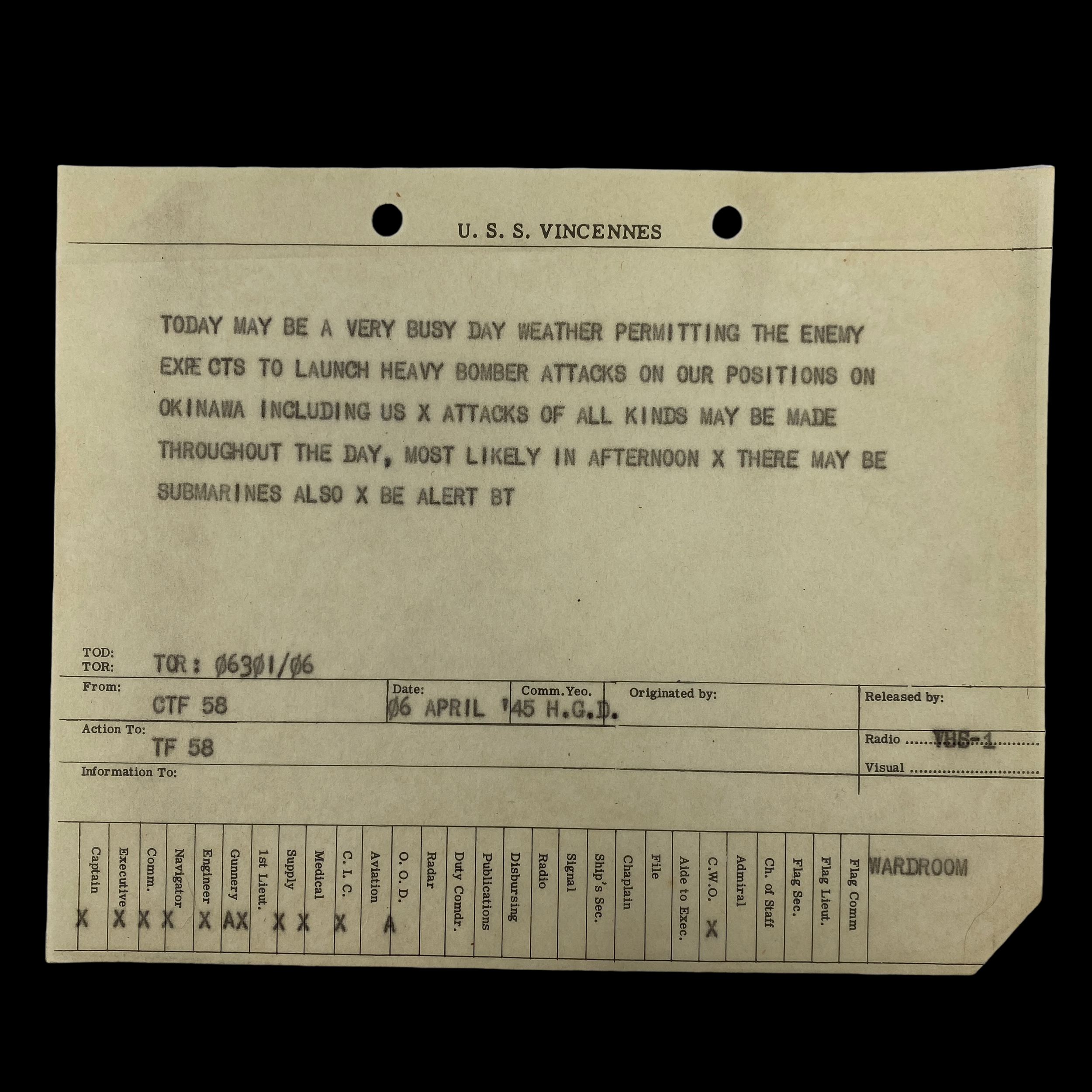


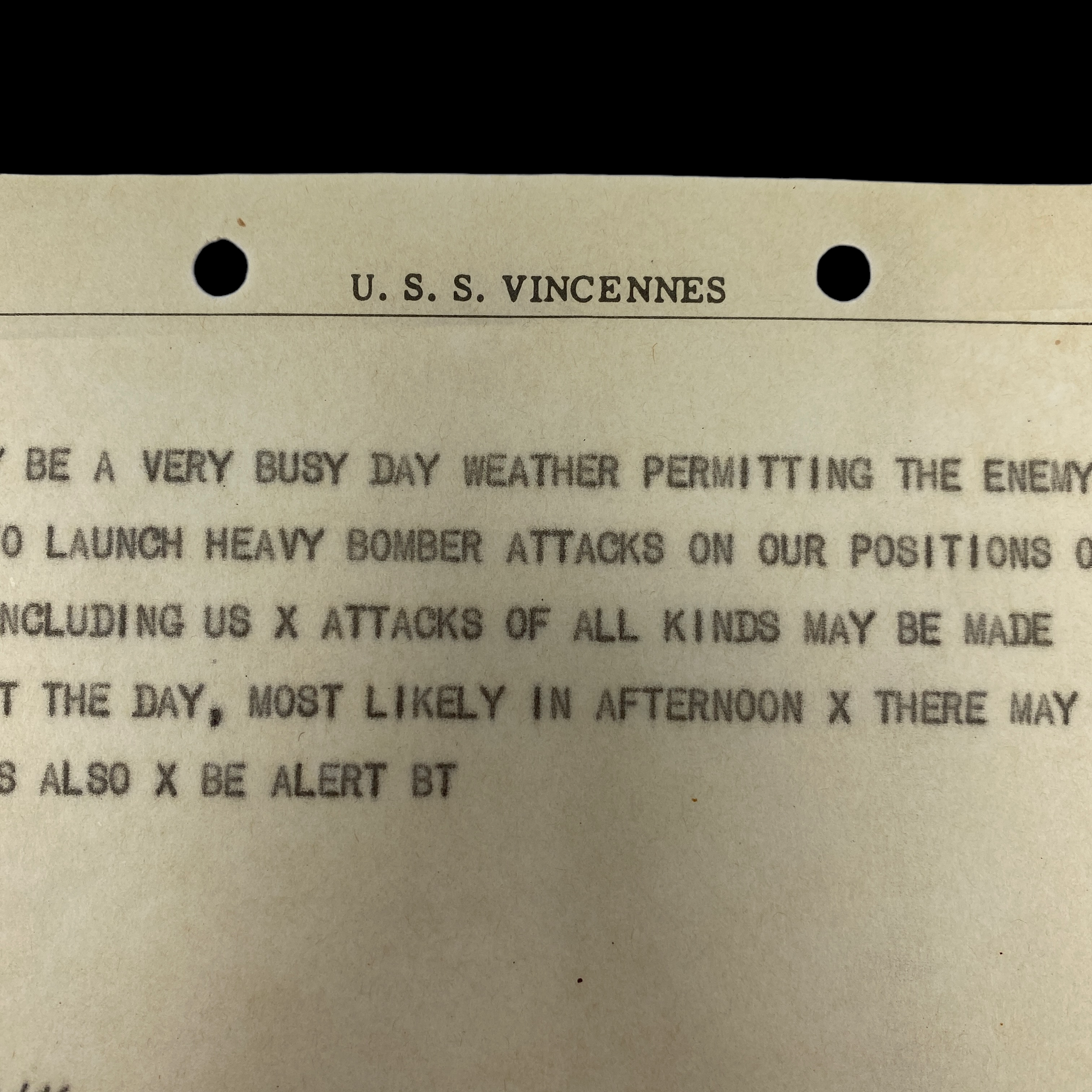
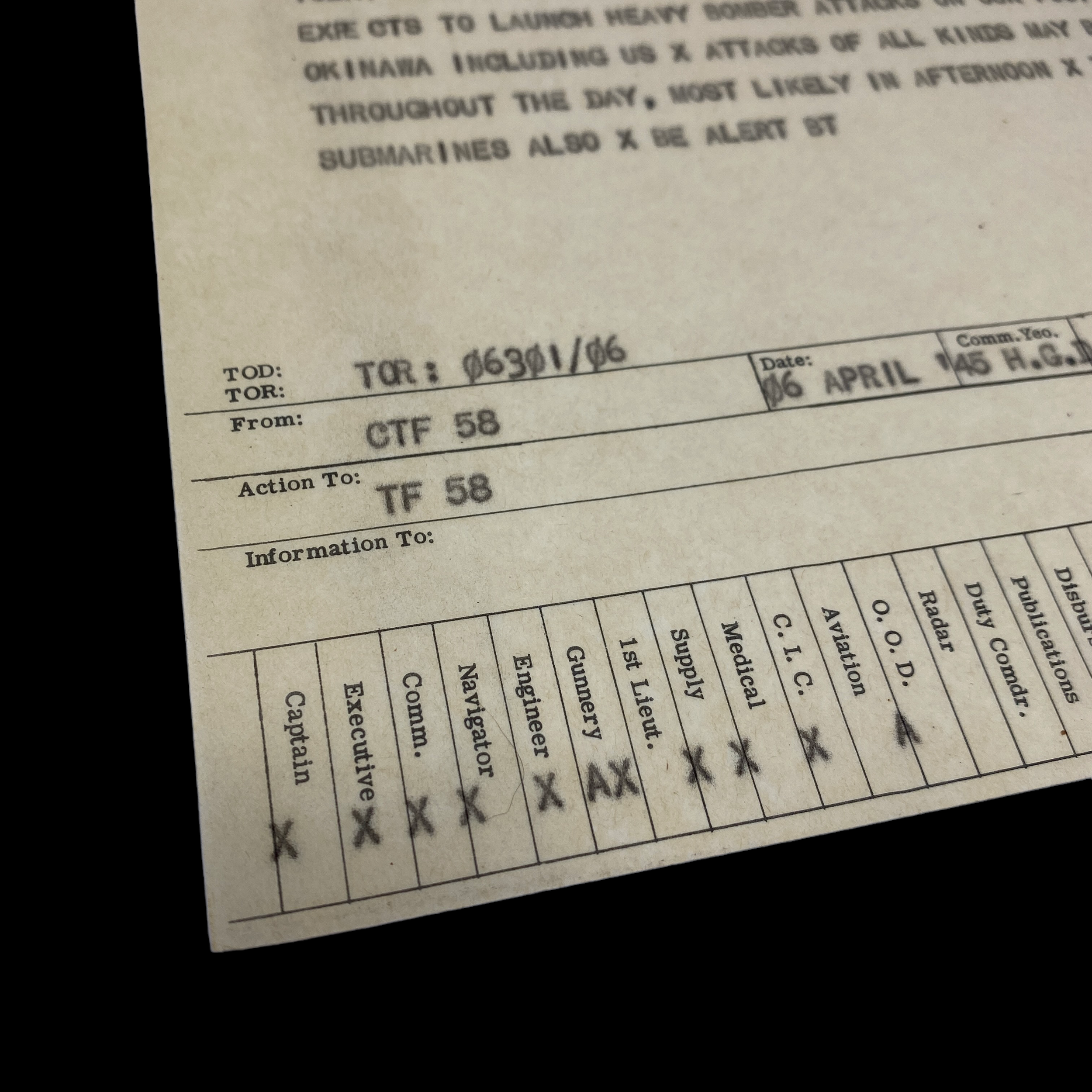
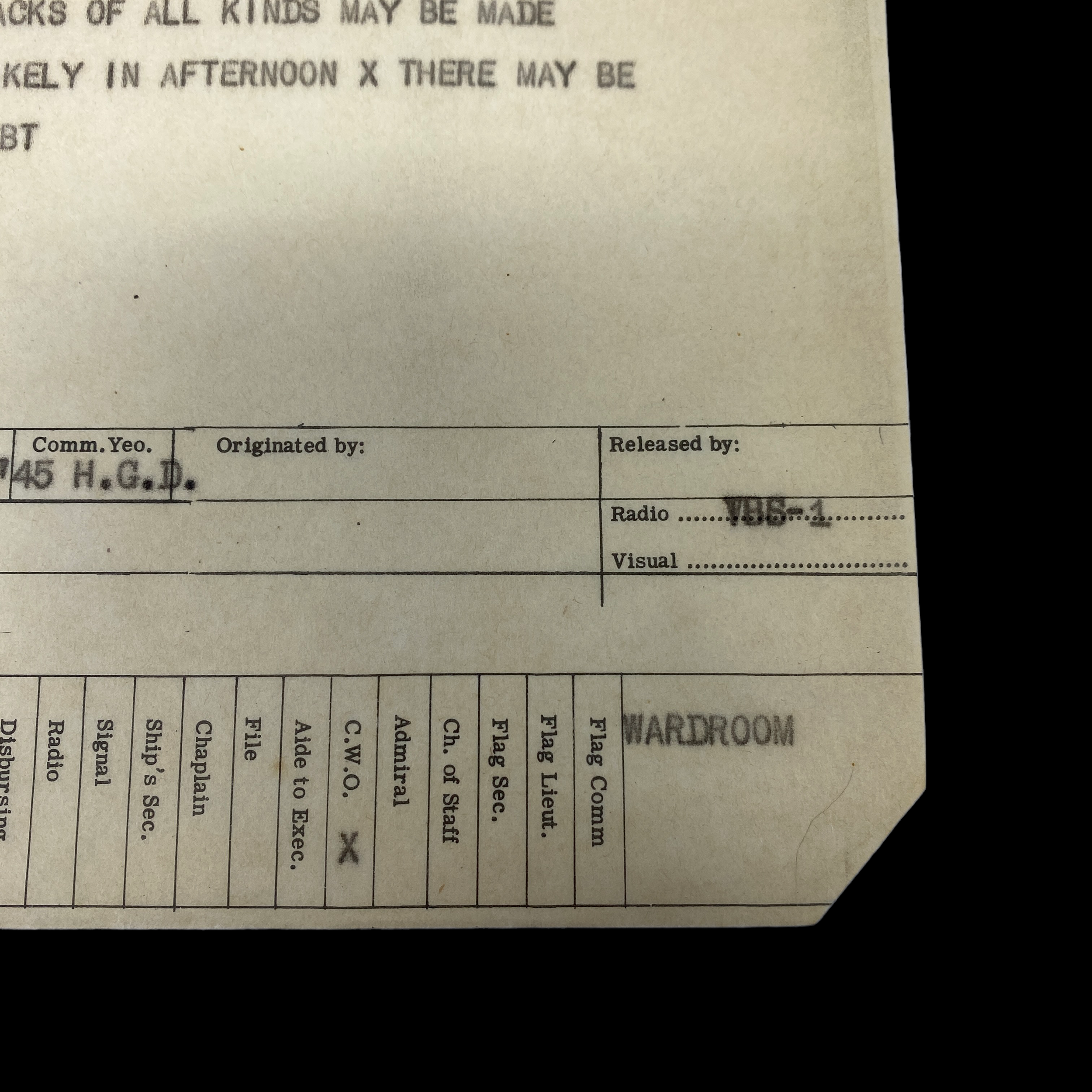
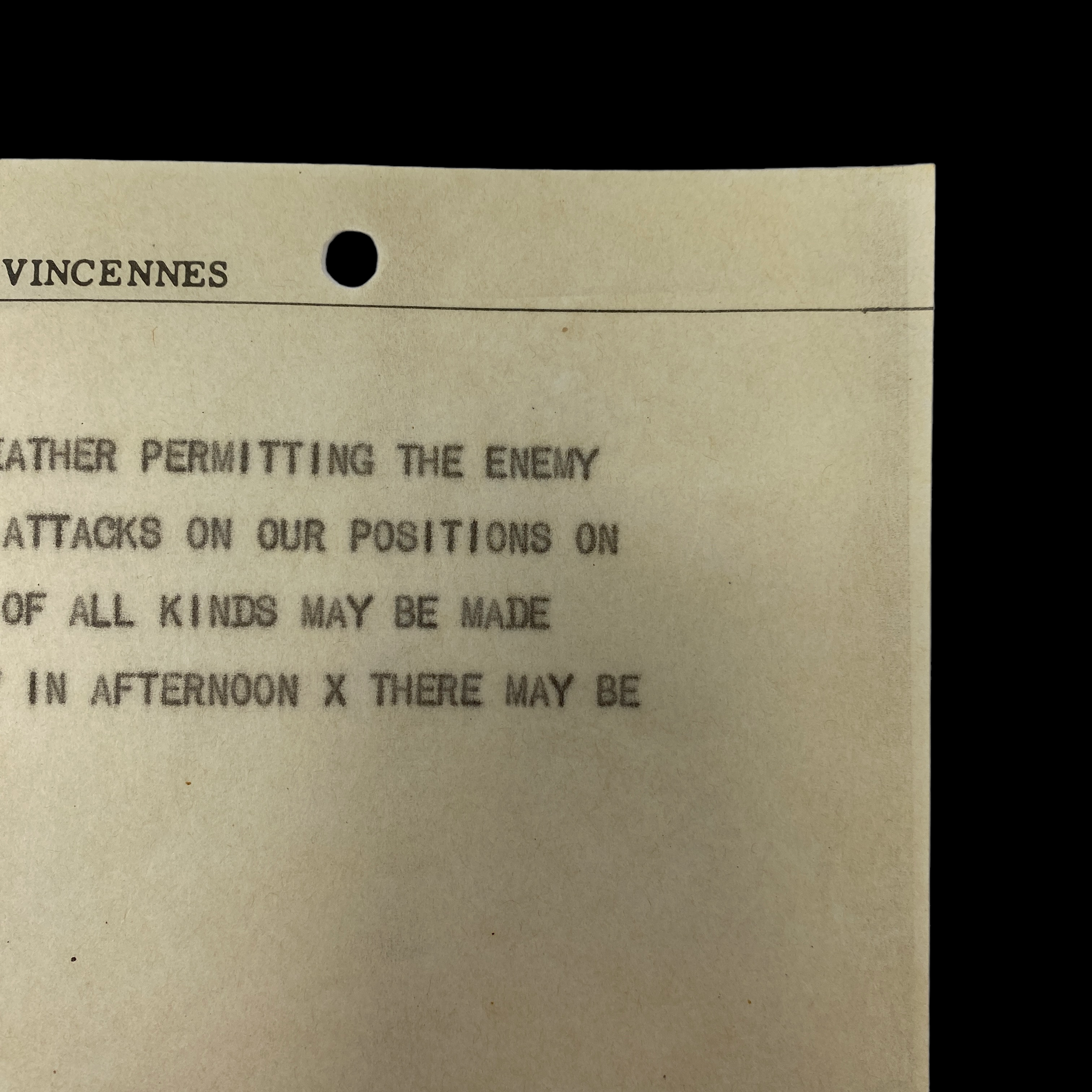
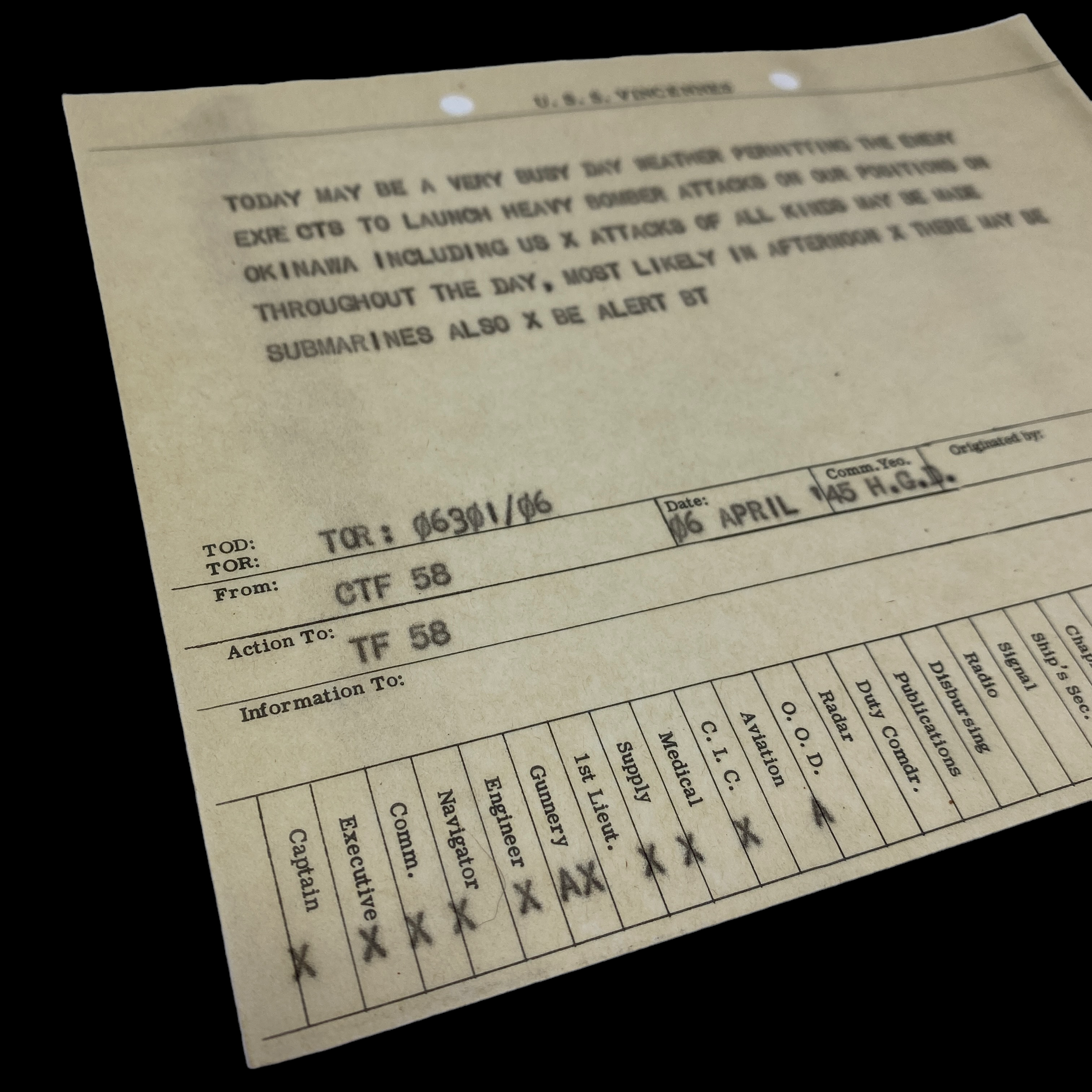
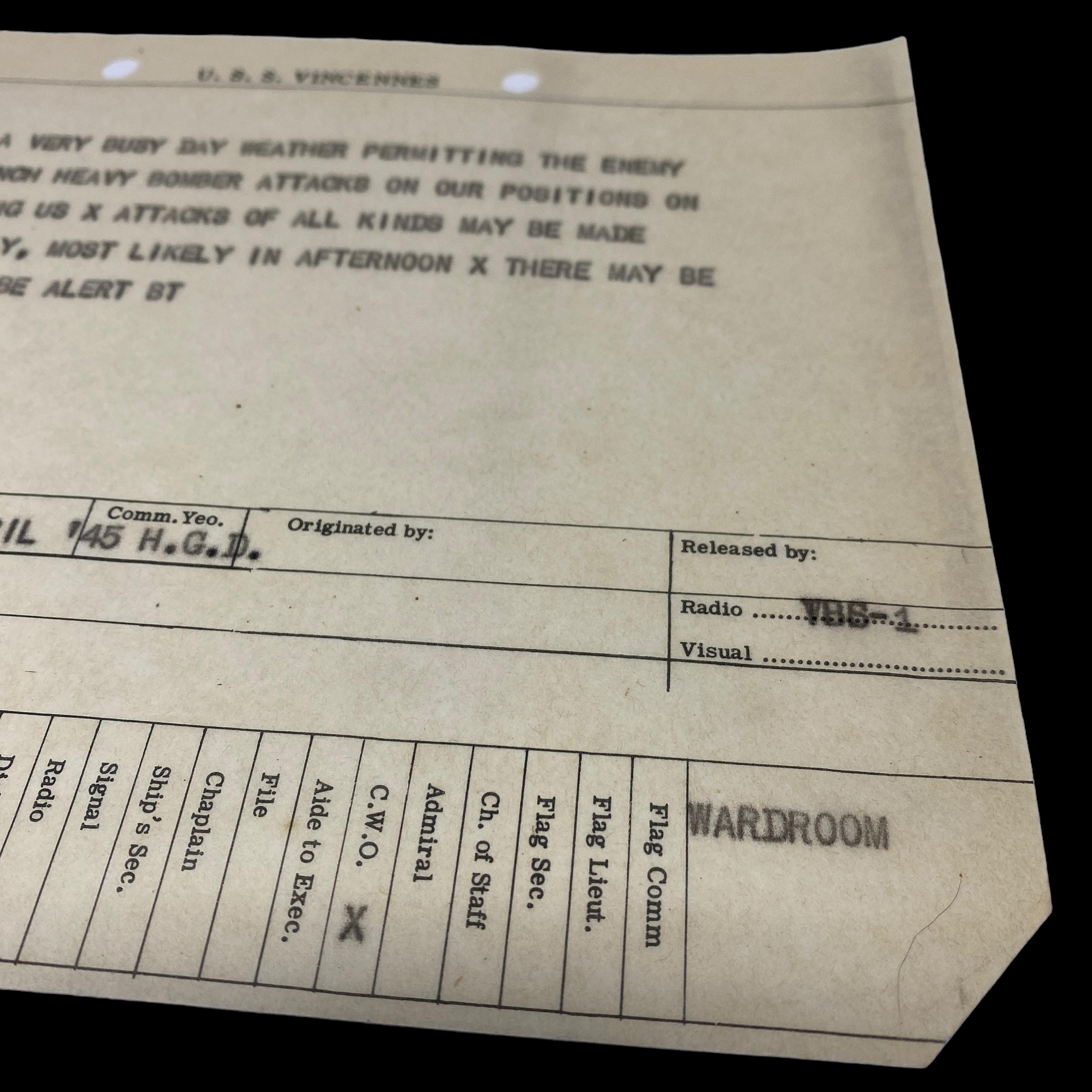


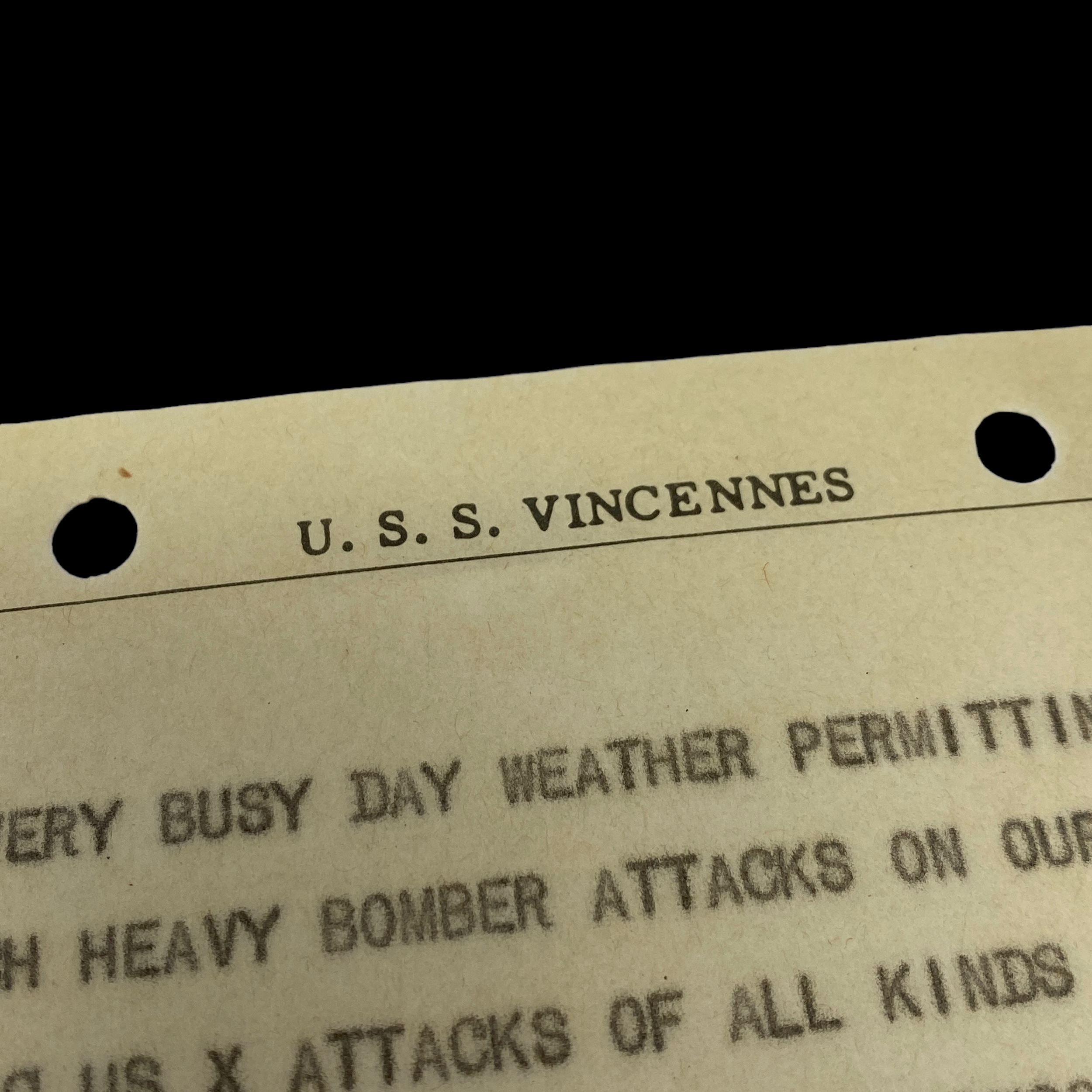





VERY RARE! WWII April 6th, 1945 Japanese Kamikaze "OPERATION TEN-GO" USS Vincennes (CL-64) Battle of Okinawa U.S. Navy Task Force 58 Intelligence Report
Comes with hand-signed C.O.A. and a full historical write-up.
“Japanese air opposition had been relatively light during the first few days after the landings. However, on April 6th, 1945, the expected air reaction began with an attack by 400 Japanese kamikaze planes from Kyushu. Periodic heavy air attacks continued through April. During the period 26 March – 30 April, twenty American ships were sunk and 157 were damaged by enemy action. For their part, by 30 April, the Japanese had lost more than 1,100 planes to Allied naval forces alone”.
This incredibly rare and museum-grade original U.S. Navy Task Force 58 intelligence message was printed and sent directly to the USS Vincennes (CL-64) on April 6th, 1945…just 5 days after the D-Day landings on Okinawa also known as Operation Iceberg. What makes this Task Force 58 USS Vincennes (CL-64) intelligence report extremely rare is that this intelligence report is the first report sent to U.S.N. ships off the coast of Okinawa warning them of a large-scale Japanese attack on U.S. ships. This report was correct intelligence of what would be famously known as “OPERATION TEN-GO”. This report on Task Force 58 report on April 6th, 1945 warns of Kikusui (“Floating Chrysanthemums”) Attack No. 1. This a one-of-one museum-grade WWII artifact and is the only OPERATION TEN-GO warning report known to exist of Japanese Kamake Floating Chrysanthemums Attack No. 1.
The United States Navy's Task Force 58, deployed to the east of Okinawa with a picket group of 6 to 8 destroyers, kept 13 carriers (7 CVs and 6 CVLs) on duty from 23 March to 27 April and a smaller number thereafter. Until 27 April, a minimum of 14 and up to 18 escort carriers (CVEs) were in the area at all times. Until 20 April, British Task Force 57, with 4 large and 6 escort carriers, remained off the Sakishima Islands to protect the southern flank.
The protracted length of the campaign under stressful conditions forced Admiral Chester W. Nimitz to take the unprecedented step of relieving the principal naval commanders to rest and recuperate. Following the practice of changing the fleet designation with the change of commanders, US naval forces began the campaign as the US 5th Fleet under Admiral Raymond Spruance but ended it as the 3rd Fleet under Admiral William Halsey.
Japanese air opposition had been relatively light during the first few days after the landings. However, on 6 April, the expected air reaction began with an attack by 400 planes from Kyushu. Periodic heavy air attacks continued through April. During the period 26 March – 30 April, twenty American ships were sunk and 157 were damaged by enemy action. For their part, by 30 April, the Japanese had lost more than 1,100 planes to Allied naval forces alone.
Between 6 April and 22 June, the Japanese flew 1,465 kamikaze aircraft in large-scale attacks from Kyushu, 185 individual kamikaze sorties from Kyushu, and 250 individual kamikaze sorties from Formosa. While US intelligence estimated there were 89 planes on Formosa, the Japanese actually had about 700, dismantled or well camouflaged and dispersed into scattered villages and towns; the US Fifth Air Force disputed Navy claims of kamikaze coming from Formosa.
The ships lost were smaller vessels, particularly the destroyers of the radar pickets, as well as destroyer escorts and landing ships. While no major allied warships were lost, several fleet carriers were severely damaged. Land-based Shin'yō-class suicide motorboats were also used in the Japanese suicide attacks, although Ushijima had disbanded the majority of the suicide boat battalions before the battle due to expected low effectiveness against a superior enemy. The boat crews were re-formed into three additional infantry battalions
Operation Ten-Go:
Operation Ten-Go (Ten-gō sakusen) was the attempted attack by a strike force of 10 Japanese surface vessels, led by Yamato and commanded by Admiral Seiichi Itō. This small task force had been ordered to fight through enemy naval forces, then beach Yamato and fight from shore, using her guns as coastal artillery and her crew as naval infantry. The Ten-Go force was spotted by submarines shortly after it left the Japanese home waters, and was intercepted by US carrier aircraft.
Under attack from more than 300 aircraft over a two-hour span, the world's largest battleship sank on 7 April 1945, after a one-sided battle, long before she could reach Okinawa. (US torpedo bombers were instructed to aim for only one side to prevent effective counter-flooding by the battleship's crew, and to aim for the bow or the stern, where armor was believed to be the thinnest.) Of Yamato's screening force, the light cruiser Yahagi and 4 of the 8 destroyers were also sunk. The Imperial Japanese Navy lost some 3,700 sailors, including Admiral Itō, at the cost of 10 US aircraft and 12 airmen.
April 6th 1945 Japanese Attack: Kikusui (“Floating Chrysanthemums”) Attack No. 1
By 6 April 1945, in reaction to the U.S. landings on Okinawa, the Japanese had amassed about 700 aircraft in Formosa and the southern Japanese island of Kyushu to attack the U.S. force. The Japanese launched their first and largest mass kamikaze attack, Kikusui No. 1, during which 230 Japanese navy and 125 Japanese army (355 total) kamikaze attacked U.S. ships off Okinawa through 7 April. Another 340 or so planes conducted conventional attacks. Some attacks occurred in large formations and others occurred in small numbers or even by single aircraft at almost all hours, so the threat was near constant. Dawn and especially dusk were the worst times, as the Japanese tried to time the bigger raids for when U.S. combat air patrols were returning to their carriers before nightfall.
Haynsworth (DD-700). Destroyer Haynsworth was patrolling off Okinawa when she was attacked by a Judy dive-bomber at about 1300. After the plane’s bomb missed by 1,000 yards (the plane was being pursued by Hellcat fighters and may have jettisoned the bomb). The Judy then came in for a kamikaze attack, hitting Haynsworth at the front of the forward superstructure and sending a fireball through the combat information center, main radio room, and radar transmitter room. Haynsworth’s casualties were seven dead and 25 wounded. She remained in action. On the following day and rescued eight crewmen from the carrier Hancock (CV-19) who had ended up in the water after the carrier was hit by a kamikaze. Haynsworth then proceeded to Mare Island for repairs.
Bush (DD-529)* and Colhoun (DD-801)*. The destroyer Bush (DD-529) was on duty on radar picket station No. 1 (the northernmost on the flight path from Kyushu) when Kikusui No. 1 came in. Many of the kamikaze pilots were very inexperienced and went for the first ship they saw, and, as a result, the radar pickets often bore the brunt of the attacks. After troops had been put ashore on Okinawa, some amphibious craft such as LCS’s were assigned to radar picket stations to add some anti-aircraft fire, act as rescue vessels, and occasionally became targets themselves.
Destroyer Colhoun was operating nearby on radar picket station No. 2 and had been attacked 11 times by Japanese bombers during the course of the day, but all bombs had missed in what appeared to be more nuisance attacks. However, about 1500, 40 to 50 Japanese kamikaze approached from Kyushu and commenced attacks on Bush, while another 12 went after destroyer Cassin Young (DD-793) occupying radar picket station No. 3 to the east of Bush and Colhoun.
As the mass attack commenced, Bush shot down two Val dive-bombers and drove off two others. Then a Jill torpedo bomber (carrying a bomb) bore in for an attack with an apparently skilled pilot who jinked and wove his way through a torrent of anti-aircraft fire, hitting Bush amidships between the two stacks. The plane’s bomb detonated in the forward engine room, killing everyone in the space along with most of the crewmen in both fire rooms. Escaping steam smothered the fires (and killed crewmen) and mobile hand-pumps were used to control flooding. Although badly damaged and dead in the water, the list was corrected and it appeared Bush could be saved. Colhoun began closing at 35 knots to assist, bringing four combat air patrol fighters along, to join four that arrived overhead Bush. Additional fighters were dispatched, but soon there were so many Japanese aircraft that it turned into a giant air-to-air mêlée over the radar picket stations.
At 1635, Colhoun arrived in sight of the afire Bush just in time to interpose herself between Bush and an incoming flight of 15 Japanese aircraft. Colhoun shot down one kamikaze, which crashed between the two ships, then shot down a second and a third, until a fourth already flaming kamikaze hit the Colhoun amidships, killing the gunners in the 40-mm mounts while the plane’s bomb exploded in the after fireroom, killing everyone in the space and rupturing the main steam line. In the meantime, another kamikaze made directly for the Bush, and with his ship a sitting duck, the commanding officer ordered all the crewmen who were topside fighting the fires (about 150) to jump overboard for safety, but the 40-mm gunners continued firing and the plane turned away looking for easier pickings.
Just as Colhoun was getting her fires under control, at 1717 she was attacked by three more kamikaze. One kamikaze was shot down by Colhoun’s gunners, and a second downed by fire from Bush and LCS-84. The third kamikaze crashed into Colhoun’s forward fire room, and the bomb detonated, blowing both boilers and breaking the keel, and the ship lost all power and communications and went dead in the water. Nevertheless, damage control teams once again got the fires and flooding under control, but at 1725 yet another kamikaze attack came in, with three planes approaching from three directions simultaneously. Colhoun, with all guns in manual, shot down one kamikaze and hit the other two, which both kept coming. One hit the after stack, fell on top of the Number 3 5-inch gun, fell over the side where it exploded, dousing the fires, but washing everyone on the fantail overboard. The third kamikaze missed Colhoun and went for Bush, hitting her amidships with such force the Bush’ hull was virtually severed in two, with only her keel holding her together. Nevertheless, her crewmen climbed out of the water and had the fires almost under control again when she was hit by a fourth kamikaze. This crashed into her port side and ignited a massive fire that killed (or fatally burned) all the wounded who had been collected in the wardroom, and the entire bow of the ship was in flames.
Still, neither crew would give up their ship. Colhoun’s crew continued with a bucket brigade. Expecting his ship to break in two, Bush’s commanding officer tried to take steps to ensure that both halves would be salvageable. At 1800, yet another kamikaze made a run at Bush, but apparently decided she was already done for and crashed into Colhoun instead, despite receiving multiple hits from Colhoun’s gunners, who wouldn’t give up. Bush’s crew continued to try to save her, but, as dusk approached, she lost her fight to a very large swell that caused her tortured keel to break, and both hull segments finally went under. LCS-64, damaged herself in the battle, picked up some of Bush’s survivors. Others were picked up during the night, but a number died in the cold water from wounds and hypothermia. Bush lost 94 valiant men, including the commander of Destroyer Division 98, Commander James S. Willis, and 32 wounded of 333 aboard. Commanding Officer Commander Rollin Everton Westholm would be awarded the Navy Cross (to go with a Silver Star awarded while in command of PT-112 during action off Guadalcanal in 1943). Willis was also awarded a posthumous Navy Cross.
Destroyer Cassin Young arrived on scene as Colhoun’s commanding officer, Commander George Rees Wilson, had finally—and reluctantly—given the order to abandon ship. LCS-84 picked up about 200 of Colhoun’s crew, which were transferred to Cassin Young. LCS-87 came alongside Colhoun and took off the remaining men, except for a skeleton crew of four officers and 17 men who were still trying to save the ship. By the time the fleet tug Pakena arrived at 2320, the fires had flared up again, the ship was listing 23 degrees, and could not be towed in the rough sea. LCS-87 took off the skeleton crew and Cassin Young sank the gallant Colhoun with gunfire. Colhoun’s casualties included 35 dead and 21 wounded. Wilson was awarded his second Navy Cross (to go with a Navy Cross and Silver Star awarded while in command of destroyer Chevalier [DD-451] in actions in the central Solomon Islands in 1943).
Newcomb (DD-586) #. At about 1800 6 April, as the battleship bombardment force was withdrawing from the beachhead area to their night disposition, 12 Kate torpedo bombers and Oscar fighters came in so low that lookouts saw them before radar. All ships opened fire with a massive volume of anti-aircraft fire. Newcomb was the first to be hit when a kamikaze crashed into her after stack. The destroyer shot down a second kamikaze, but, at 1806, a third hit her amidships and the large bomb or torpedo the plane was carrying exploded deep in the ship, destroying both engine rooms and the forward fire room. Despite the severe damage, Newcomb’s forward guns kept firing on a fourth kamikaze, which kept on coming and struck the ship on the forward stack, adding a new supply of gasoline to the already raging inferno in Newcomb’s mid- section. In the smoke of the explosion, observers on other ships first assumed Newcomb had gone down.
Leutze (DD-481) raced to rescue survivors, swinging her boats out to lower them in the water, only then to discover Newcomb was still afloat despite the mass of flame from her bridge to her Number 3 gun. Leutze’s commanding officer was 1941 Naval Academy graduate, Lieutenant Leon Grabowsky, in command since the ship’s commanding officer had been badly wounded when she was hit by shore fire off Iwo Jima. Grabowski brought Leutze alongside Newcomb at 1811, passing hoses over to help fight the fires. At 1815, a fifth kamikaze was aiming for Newcomb’s bridge, but was hit by a 5-inch shell and crashed onto Leutze’s fantail instead, starting a fire in the after ammunition-handling room, jamming her rudder, and opening many compartments to the sea. One of Leutze’s repair parties continued to fight the fires on Newcomb while others fought to save Leutze, which was in danger of sinking herself. There were numerous accounts of heroism on both ships, but Morison’s quote from Lord Nelson probably sums it up: “They fought as one man and that man a hero.” Newcomb’s valiant crew, under the command of Commander Ira E. McMillian, saved their ship at a cost of 43 dead and 64 wounded. McMillian would be awarded the Navy Cross (to go with the Silver Star he had received while in command of Newcomb during the Battle of Surigao Strait). Newcomb was awarded a Navy Unit Commendation. She was ultimately towed back to the United States, but was not repaired.
Leutze (DD-481) #. After disengaging from her heroic attempt to assist Newcomb when destroyer Beale (DD-471) came alongside to assist, Leutze’s crew brought the fire and flooding under control and she was towed into Kerama Retto by minesweeper Defense (AM-317), herself hit by two kamikaze that luckily caused only minor damage and only wounded nine. Leutze lost 8 crewmen and 34 wounded. Acting Commanding Officer Lieutenant Grabowsky was awarded the Navy Cross. His award citation states: “…Although substituting for LEUTZE’s regular commanding officer [he] handled his ship like a veteran commander and maintained a high standard of fighting efficiency on board his gallant craft throughout a long and terrific aerial attack. By his fearless leadership and outstanding courage in the face of grave danger, he contributed to the destruction of an enemy plane and to the preservation of his own and another destroyer….” Luetze was brought back to the United States, but repairs were halted at the end of the war and never completed.
Defense (AM-317) ##. After shooting down one kamikaze, being hit by two, rescuing 60 sailors from destroyer Newcomb and towing crippled destroyer Leutze into Kerama Retto, Defense sailed for the U.S. West Coast, but her repairs were not completed until after the war ended. During the kamikaze hits on 6 April, Defense suffered nine wounded.
Witter (DE-636) # and Morris (DD-417) #. Destroyer escort Witter was operating with destroyer Gregory (DD-802) on anti-submarine patrol duty off southern Okinawa when they were attacked by two Japanese aircraft at 1612. Gregory shot one down and Witter gunners hit the other, but the burning plane kept coming and hit Witter at the waterline, with the plane’s bomb exploding in the forward fire room, and killing six crewmen and wounding six. Damage control parties got the flooding under control and Witter was steaming on her own power toward Kerama Retto at ten knots, accompanied by Gregory, destroyer Morris (DD-417), Richard P. Leary (DD-664), and the tug Arikara (ATF-98).
Morris detached from the group, but then came under attack by a single Kate torpedo bomber. Although Morris gunners hit the Kate repeatedly, it kept coming and crashed on the port side between 5-inch gun mounts Number 1 and 2, igniting stubborn fires that took two and a half hours to put out. Richard P. Leary arrived to assist and escorted Morris to Kerama Retto. Morris suffered 13 killed and 45 wounded. Although both Witter and Morris eventually made their way back Stateside, repairs were never fully completed on either ship.
Hyman (DD-732). Destroyer Hyman was covering the transport area when she was attacked by four kamikaze at 1612 on 6 April. Hyman shot down three of the kamikaze, but was hit by the fourth on her torpedo tubes, which resulted in a massive explosion and flooded the forward engine room. As damage control parties stopped the flooding and put out the fires, Hyman’s gunners, along with gunners on destroyer Rooks (DD-804), which had come to Hyman’s aid, helped to down two more kamikaze. Rooks had already shot down five Japanese aircraft earlier in the day and would remain in nearly constant action off Okinawa until late June, suffering no hits and no casualties in an incredible lucky streak. Hyman suffered 12 killed and over 40 wounded, but the ship was saved. She returned from repair in the United States just in time for the Japanese surrender.
Howorth (DD-592). Destroyer Howorth was steaming with light cruiser St. Louis (CL-49), protecting the transport area, when a two-plane Japanese kamikaze attack came in about 1600. The two ships combined to shoot the first kamikaze down. The second kamikaze barely missed Howarth, passing between her stacks and crashing in the water on the far side. Howarth began heading to assist Hyman, when two groups of four Zeke fighters commenced an attack on her. From the first group, one was shot down, two missed, and the fourth just grazed the fantail before hitting the water. A fifth Zeke was shot down, but the sixth aimed for and hit the main battery gun director, killing nine and wounding 14. As damage control parties were quickly bringing the fires under control, Howarth’s 40-mm guns shot down yet another Zeke attacking from the stern. Howarth made it to Kerama Retto under her own power and then Stateside for repairs.
Mullany (DD-528) ##. Destroyer Mullany was on anti-submarine patrol when she was attacked by a solo kamikaze at 1745. Despite being hit numerous times, the kamikaze kept coming and crashed into the after deckhouse. As damage control parties swung into action, Mullany’s depth charges blew up in a massive explosion. As the ship’s crew struggled to keep her afloat, Mullany’s forward gunners engaged three more inbound kamikaze, downing two and causing the third to turn away. After an hour of fighting the fire, the temperature in the aft magazine reached a level where it was at risk of exploding, and the commanding officer, Commander Albert Momm, gave the order to abandon ship. Minesweepers Gherardi (DMS-30) and Execute (AM-232) rescued survivors and were then joined by destroyer Purdy (DD-734), which came alongside to fight the fires. Commander Momm took a skeleton crew back on board. An attempt to tow Mullany failed, but the skeleton crew was able to light off one boiler and get her underway again to Kerama Retto. Mullany suffered 30 dead and 36 wounded. She eventually made her way back to the United States, but repairs were not complete before the war ended.
Fieberling (DE-640). Destroyer escort Fieberling suffered damage from a near miss by a kamikaze, but incurred no casualties. She escorted a convoy of unloaded transports to Guam and, after repairs, returned to Okinawa on 28 June.
Rodman (DD-456/DMS-21) ## and Emmons (DD-457/DMS-22)*. The destroyer-minesweepers Rodman and Emmons were covering a group of six small minesweepers sweeping a channel off Okinawa, when they were attacked by a large group of kamikaze. The first kamikaze popped out of the clouds with little warning, hitting Rodman from forward and its bomb exploded under the superstructure. Damage control teams brought the fires under control by 1600 and Rodman’s engineering plant was still in order. Emmons was maneuvering to assist Rodman, when the swarm of kamikaze descended. Emmons circled the wounded Rodman, shooting down six kamikaze, but two got through to Rodman and crashed into her, one causing a fire that gutted the superstructure after hitting the captain’s cabin.
At this point, a large number of Marine Corps fighters arrived overhead and engaged the Japanese, shooting down as many as 20 aircraft. Emmons downed six more kamikaze, but was then overwhelmed. Marine Corsairs bravely flew into Emmons’ anti-aircraft fire in pursuit, but couldn’t prevent the ship from being hit by five kamikaze in quick succession; four others narrowly missed. Emmons’ fantail and rudder were blown off when two of the kamikaze crashed into her stern simultaneously. A third hit her forward 5-inch gun. The fourth hit just under the bridge, killing everyone in the combat information center (four officers and ten men). Intense fire went into the pilothouse, forcing the badly burned commanding officer, Lieutenant Commander Foss, and others to seek shelter on the bridge, which, however, was gone, and they were forced to jump over the side. The fifth kamikaze strafed the ship, then circled back and crashed into the already destroyed superstructure.
The gunnery officer, Lieutenant J. J. Griffin, took command of Emmons as the wounded skipper was in the water and the executive officer was dead. Gun crews were still firing and downed a sixth inbound kamikaze. The ship was listing ten degrees, fires burning throughout and ready ammunition was exploding, but the good news was the sprinklers in the ammunition-handling rooms worked and the power plant was intact. Griffin worked to save the ship, as teams brought the superstructure fire under control, topside weight was jettisoned, and the less-severely wounded were put overboard in life rafts. After an hour of fighting the fire forward, there was a large explosion in the forward handling room. With help, the ship might still have been saved, but the damaged Rodman was in no condition to help anyone and all fleet tugs were occupied with other cripples. The small minesweepers had rescued some Emmons crewmen from the water, including the skipper.
Griffin finally gave the abandon-ship order. The small mine disposal vessel PGM-11 stood by Emmons until the end, coming alongside the burning ship to take off the last 60 men around 2000. Still, Emmons drifted for another two hours until destroyer-minesweeper Ellyson (DMS-19) arrived, but couldn’t put a party aboard due to the rough sea. On order, she sank the valiant Emmons with gunfire. Of Emmons’ crew, eight of 19 officers and 53 out of 237 men were killed, with four officers later succumbing to burn wounds; 71 others were wounded.
Rodman made it to Kerama Retto with 16 dead and 20 wounded. Her repairs were not completed before the war ended. (Rodman went on to star as the fictitious USS Caine in the movie The Caine Mutiny in 1954 before being transferred to the Taiwanese navy, where she was involved in two collisions—earning the nickname in Chinese for “Ram”—and finally running aground in 1969.)
Emmons was awarded a Navy Unit Commendation for actions prior to her sinking. Her crew were awarded a Navy Cross, four Silver Stars, and eight Bronze Stars. Lieutenant Griffin was awarded one of the Silver Stars (I can’t find who received the Navy Cross). Emmons’ wreck site was discovered in shallow water in 2001 and has become a popular dive suite. The builder’s plaque was illegally removed by a diver. Warship wrecks and their contents remain sovereign property of their nation in perpetuity, and, working with NCIS, NHHC was able to recover the plaque. It has since undergone extensive conservation treatment to prevent the rapid deterioration that occurs when an artifact is improperly removed from salt water.
LST-447 *. Besides being a place of refuge for damaged ships, Kerama Retto also had a large concentration of ammunition and fuel ships. As LST-447 was approaching the Kerama roadstead at 1627, she spotted two Zeke fighters heading in to the anchorage, opened fire, and hit one of them, which then changed course and aimed for the landing ship. Despite being hit by more anti-aircraft fire, the Zeke crashed the ship just above the waterline and its bomb exploded inside the LST, starting a massive fire. Within ten minutes, the vessel had to be abandoned, and then burned for 24 hours before she finally sank. Five crewmen were killed and 17 wounded.
Hobbs Victory * and Logan Victory *. Meanwhile, other kamikaze passed up the LST and took aim at the escort carrier Tulagi (CVE-72) and three Victory ships being used as ammunition carriers. One kamikaze commenced a run on Tulagi, but shifted to Logan Victory instead. Her Merchant Marine crew promptly abandoned her; most of the 16 dead and 11 wounded were in the Naval Armed Guard. Hobbs Victory quickly got underway, but was hit in the aft of her bridge and also quickly abandoned, with 15 killed and three wounded. Both ships drifted burning and exploding for a day before any ship went close enough to sink them with gunfire. The Navy-manned Las Vegas Victory was in the act of offloading ammunition onto smaller landing craft and shot down the kamikaze that tried to attack her.
Battle of Okinawa:
The Battle of Okinawa was the last major battle of World War II, and one of the bloodiest. On April 1, 1945—Easter Sunday—the Navy’s Fifth Fleet and more than 180,000 U.S. Army and Marine Corps troops descended on the Pacific island of Okinawa for a final push towards Japan. The invasion was part of Operation Iceberg, a complex plan to invade and occupy the Ryukyu Islands, including Okinawa. Though it resulted in an Allied victory, kamikaze fighters, rainy weather and fierce fighting on land, sea and air led to a large death toll on both sides. As dawn arrived on April 1, morale was low among American troops as the Fifth Fleet launched the largest bombardment ever to support a troop landing to soften Japanese defenses. Soldiers and Army brass alike expected the beach landings to be a massacre worse than D-Day. But the Fifth Fleet’s offensive onslaught was almost pointless and landing troops could have literally swum to shore—surprisingly, the expected mass of awaiting Japanese troops wasn’t there. On D-Day along the shores of northern France, American troops fought hard for every inch of beachhead—but troops landing on Okinawa’s beaches surged inland with little resistance. Wave after wave of troops, tanks, ammunition and supplies went ashore almost effortlessly within hours. The troops quickly secured both Kadena and Yontan airfields. Japan’s 32nd Army, some 130,000 men strong and commanded by Lt. Gen. Mitsuru Ushijima, defended Okinawa. The military force also included an unknown number of conscripted civilians and unarmed Home Guards known as Boeitai. As they moved inland, American troops wondered when and where they’d finally encounter enemy resistance. What they didn’t know was the Japanese Imperial Army had them just where they wanted them. Japanese troops had been instructed not to fire on the American landing forces but instead watch and wait for them, mostly in Shuri, a rugged area of southern Okinawa where General Ushijima had set up a triangle of defensive positions known as the Shuri Defense Line. American troops who headed North to the Motobu Peninsula endured intense resistance and over 1,000 casualties but won a decisive battle relatively quickly. It was different along the Shuri Line where they had to overcome a series of heavily defended hills loaded with firmly-entrenched Japanese troops.
On April 7, Japan’s mighty battleship Yamato was sent to launch a surprise attack on the Fifth Fleet and then annihilate American troops pinned down near the Shuri Line. But Allied submarines spotted the Yamato and alerted the fleet who then launched a crippling air attack. The ship was bombarded and sank along with most of its crew. After the Americans cleared a series of outposts surrounding the Shuri Line, they fought many fierce battles including clashes on Kakazu Ridge, Sugar Loaf Hill, Horseshoe Ridge and Half Moon Hill. Torrential rains made the hills and roads watery graveyards of unburied bodies. Casualties were enormous on both sides by the time the Americans took Shuri Castle in late May. Defeated but not beaten, the Japanese retreated to the southern coast of Okinawa where they made their last stand. The kamikaze suicide pilot was Japan’s most ruthless weapon: On April 4, the Japanese unleashed these well-trained pilots on the Fifth Fleet. Some dove their planes into ships at 500 miles per hour, causing catastrophic damage. American sailors tried desperately to shoot the kamikaze planes down but were often sitting ducks against enemy pilots with nothing to lose.
During the Battle of Okinawa, the Fifth Fleet suffered:
• 36 sunk ships
• 368 damaged ships
• 4,900 men killed or drowned
• 4,800 men wounded
• 763 lost aircraft
USS Vincennes Combat History During WWII:
USS Vincennes, a 10,000-ton Cleveland class light cruiser built at Quincy, Massachusetts, was commissioned in January 1944. She performed shakedown operations in the Caribbean area and was subsequently transferred to the Pacific war zone, arriving at Pearl Harbor, Hawaii, early in May. The new cruiser was soon in action, taking part in the Marianas Campaign in June, July and August 1944 as part of Task Force 58. During this time she screened aircraft carriers during the Battle of the Philippine Sea and strikes on the Mariana, Bonin and Volcano Islands.Vincennes continued to operate with the fast carriers during the Palaus Campaign in September, strikes in the Western Pacific in October, the Battle of Leyte Gulf on 24-25 October, and operations connected with the Philippines Campaign from November 1944 into January 1945. She also bombarded the enemy ashore in the Palaus, helped sink a Japanese warship during the final part of the Leyte Gulf battle, covered the withdrawal of the crippled cruisers Houston (CL-81) and Canberra (CA-70) after they were torpedoed off Formosa in mid-October, and successfully rode out a bad typhoon in December. During February and March 1945, Vincennes participated in attacks on the Japanese home islands and supported the Iwo Jima Campaign, mainly as an escort for the carrier fleet, but also using her guns to shell Okino Daito Shima. After serving in the carrier screen during the first month and a half of the battle for Okinawa that began in late March, the cruiser was assigned to bombardment duties in support of ground operations there. From mid-May until mid-June, Vincennes fired nearly 6000 six-inch projectiles and over 10,500 rounds from her five-inch guns at enemy artillery, troops and supply dumps.